Book of engraved deposit certificates from the Czarnikow-Rionda Company form 1936. 20 signed and issued and 5 unissued. This historic document was printed by the American Banknote Company and has an ornate border around it with the company name on top center. This item has the hand signatures of either Manuel E. Rionda (17 times )and B. Braga Rionda (3 times) as Trustee on the face of the certificate,. In addition there are Manuel Rionda (3 times), Manuel E. Rionda (1 time), B. Braga Rionda (1 time) signatures on the back. Manuel Rionda, Manuel E. Rionda , B. Braga Rionda and Rafael Zevallos names listed as Trustees. 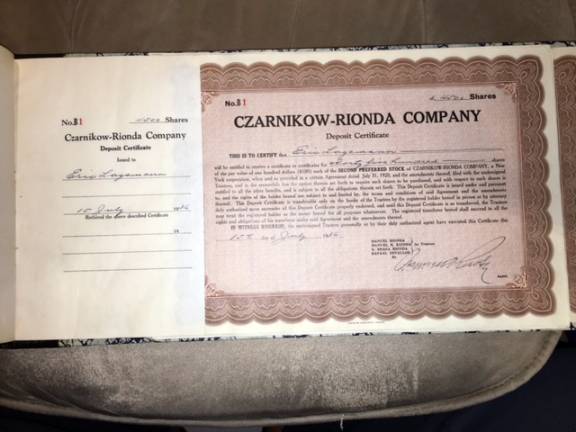
Certificate 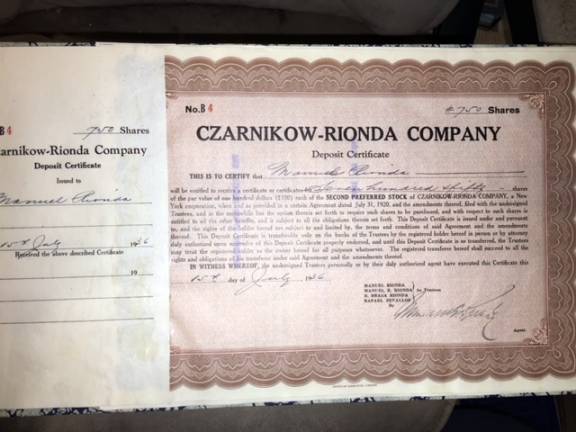
Certificate issued to Manuel Rionda 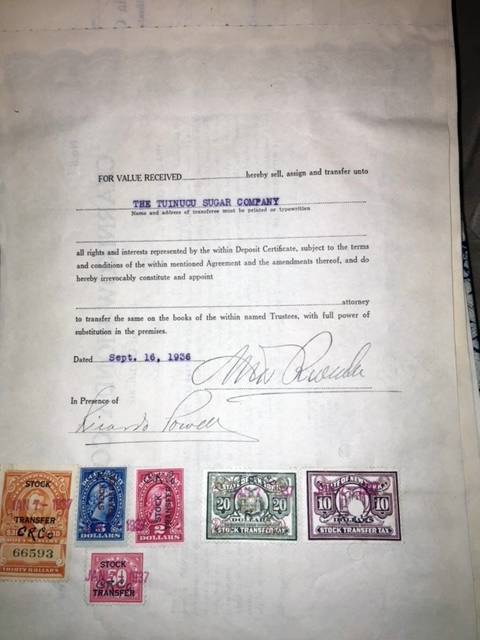
Manuel Rionda Signature 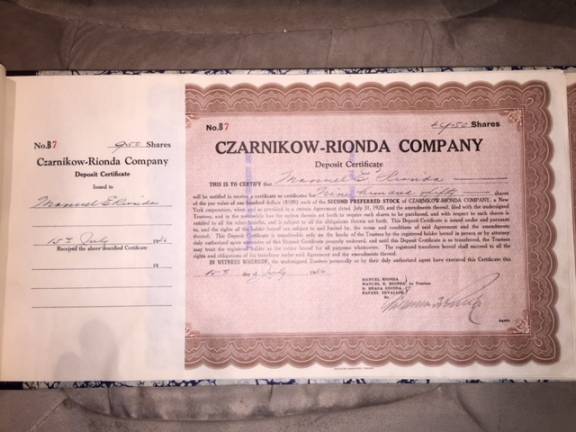
Certificate issued to Manuel E. Rionda 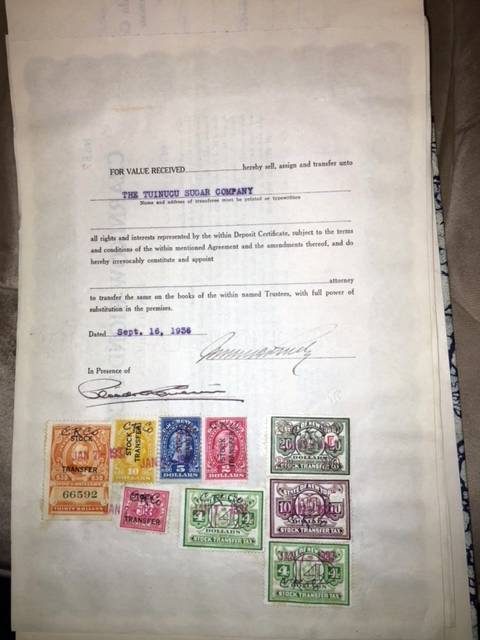
Manuel E. Rionda signature 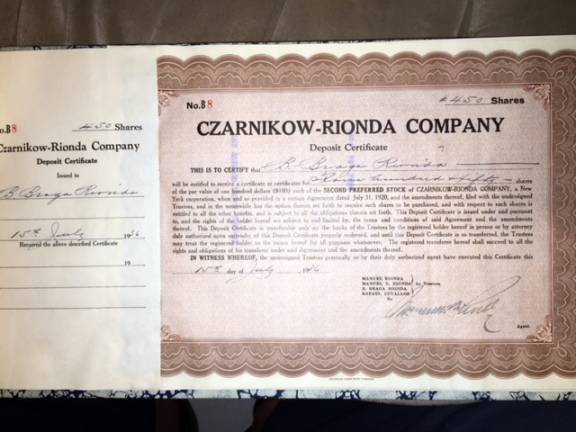
Certificate issued to B. Braga Rionda 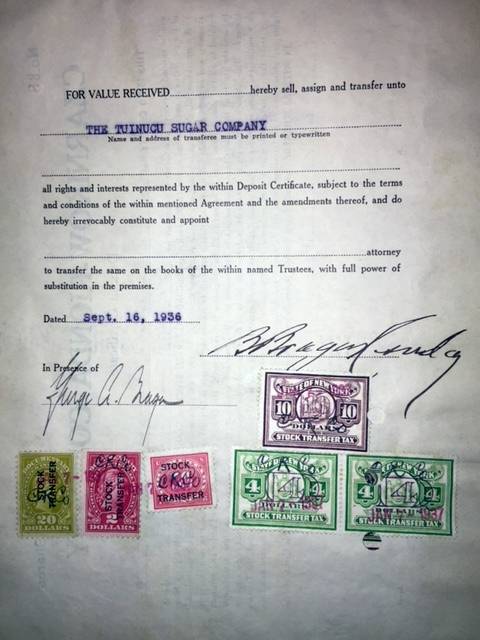
B. Braga Rionda signature Manuel Rionda was born in 1854 in Noreña, Spain.The Rionda family began investing in Cuban sugar in the 1860s. By 1870, when Rionda was sixteen, Rionda emigrated to Cuba. Rionda co-founded the Czarnikow-Rionda Company with Julius Caesar Czarnikow in 1909. By 1915, he co-founded the Cuba Cane Sugar Company with his family. Rionda was the owner of sugar plantations in Cuba.Prior to the 1930s, Czarnikow-Rionda Company "sold 40 per cent of Cuba's sugar". Rionda married Harriet Clarke.They resided at Rio Vista estate, a 300-acre estate in Alpine, New Jersey. They had no children, but they raised his orphaned nephew, Manuel Enrique Rionda, who later resided on the Glen Goin estate in Alpine with his wife, Ellen Goin. Rionda died in 1943. A tower designed by architect Charles Rollinson Lamb on his former estate still stands in Alpine, New Jersey, one of the most affluent zipcodes in the United States. Incorporated: 1909 (dissolved 1999) Employees: 48 Sales: $800 million (fiscal 1998 est.) 1960-61:Fidel Castro nationalizes all the firm's Cuban holdings. 1969: Czarnikow-Rionda is purchased by C. Brewer and Co. 1999: The firm closes its doors after big trading losses. Czarnikow-Rionda Company, Inc. was one of the largest sugar brokers in North America for almost a century, acting as a middleman between growers and refiners of sugarcane, with its principal focus on Cuba. Through affiliated companies, the firm also owned sugarcane farms and processing mills, cattle ranches, and alcoholic distilleries in Cuba and a Philadelphia sugar refinery. Czarnikow-Rionda lost all its Cuban property with the rise of Fidel Castro to power but remained one of the world's largest sugar brokers until 1999, when heavy losses on some contracts left it too deeply in debt to continue in business. Prussian-born Julius Caesar Czarnikow emigrated to England in 1854 and became a successful sugar broker, founding the firm of Czarnikow & Co. (later C. Czarnikow, Ltd.) in 1861. Czarnikow, MacDougall & Co., founded in 1891, was the New York-based North American branch of this brokerage house. Joining the firm as a commission agent in 1897 was Manuel Rionda, the younger brother of two Spanish-born brothers who had established a business empire based on Cuban sugar. By the end of 1898 both of Manuel's brothers were dead, and he was the head of the family's properties and business. Nevertheless, he continued working for Czarnikow, MacDougall which, by means of his energy and enterprise and the parent firm's capital, was the dominant power in the Cuban sugar trade by 1903. Following the death of Czarnikow in 1909, Czarnikow-McDougall was reorganized as Czarnikow-Rionda, with Rionda as president and his nephew Manuel E. (Manolo) Rionda as secretary and treasurer. (MacDougall died in 1911.) Rionda was only one of five equal partners in the company, with the other four being partners in the parent firm. Relations between Rionda and the others were never good, since he believed they were too conservative to effectively compete for the U.S. sugar market and they were reluctant to invest in Cuba because of political instability on the island. In 1915 Rionda succeeded in reducing the parent firm's participation in the New York operation. All ties were severed at some undetermined later date. In spite of its brokering activities, Czarnikow-Rionda's primary focus for its first 50 years was to import raw cane sugar and molasses from Cuban mills for delivery to refineries in the United States. Affiliates of the company did some of the planting, harvesting, transporting, and milling, but even many mills nominally independent were in fact tied to Czarnikow-Rionda by loans to finance the grinding of the cane. In turn, nominally independent planters were tied to the mills by the need to finance their activities. Czarnikow-Rionda also exported machinery, jute bags, and provisions to Cuba. By 1913 Cuba was the world's leading sugar exporter. Czarnikow-Rionda was prominent in every part of the trade. In its heyday as a broker it handled over 60 percent of Cuban sugar sales in New York and some 60 percent in the United States. The Cuban Trading Co., established in 1907 as a subsidiary or affiliate, bought sugar, arranged loans to millers and farmers, sold jute bags for transporting the milled cane, handled insurance claims, and provided legal and notary services, even resolving local disputes and acting as liaison to the Cuban government. Rionda family members were active in the business, especially Bernardo Braga Rionda, another nephew of Manuel Rionda. Several mills passed into the hands of Czarnikow, McDougall and Czarnikow-Rionda when their owners could not pay their debts. The Riondas then acquired these properties, including the sugar mills Central San Vicente, Central San Jose (reorganized as Washington Sugar Co.), Central Elia, and Central Cespedes. They also had earlier acquired Central Tuinucu. These were organized into affiliates of Czarnikow-Rionda. Francisco Sugar Co., incorporated in 1899, purchased in 1921 the common stock of the company that owned Central Elia. Its holdings, then or later, included 117 miles of railroad, a port, a cattle ranch, and an alcohol distillery. Manati Sugar Co., incorporated in 1912, operated the Riondas' largest sugar mill, Central Manati, plus more than 200,000 acres of land. Other Cuban enterprises in which Czarnikow-Rionda was involved included another alcohol distillery, two more sugar mills, a paper mill that produced cellulose from cane bagasse, a wallboard factory, and a scheme to substitute Cuban-grown kenaf for imported Asian jute in producing bags for transporting sugar. Manuel Rionda was an investor in, and first president of, the Cuba Cane Sugar Co., which in 1916 bought 17 mills, making it the largest sugar enterprise in Cuba. Backed by J.P Morgan & Co., this company controlled 16 percent of Cuba's sugar production. At its height Cuba Cane Sugar also held over 500,000 acres of purchased or leased land and 500 miles of railroad, complete with rolling stock for transporting sugarcane. Czarnikow-Rionda's fortunes reached their zenith in this period. Sugar prices rose threefold during World War I, spurring a surge in production. The postwar lifting of U.S. price controls set off a speculative frenzy that increased the value of raw sugar at least three times more in 1919. The so-called Dance of the Millions bubble burst the following year, ruining hundreds of Cuban planters and merchants. Czarnikow-Rionda survived this crisis and even purchased a Philadelphia sugar refinery, W.J. McCahan Sugar Refining and Molasses Co., in 1920. However, overproduction and low prices were a problem for the Cuban sugar trade throughout the 1920s. For a brief period in the early 1920s, Walter E. Ogilvie, a businessman who helped Rionda break another firm's monopoly on coal distribution in Cuba, served as Czarnikow-Rionda's president and tried to reorganize its operations. This endeavor was not successful, and Rionda resumed the presidency. Nearly 80 percent of all Cuban sugar was being sold to U.S. markets in 1929, but the industry had to compete against tariff-protected growers in the possessions of Hawaii, the Philippines, and Puerto Rico, as well as in the mainland United States. The situation worsened during the Great Depression, as demand fell. The Francisco, Manati, and Cespedes sugar companies, forced into receivership, were reorganized under the continued control of the Riondas. Washington Sugar and Central San Vicente were sold. Cuba Cane Sugar was dissolved in 1938. Manuel Rionda died in 1943 at the age of 89 and was succeeded as president of Czarnikow-Rionda by Bernardo Braga Rionda. The sugar refinery was sold in 1944 to the American Sugar Co. The period after World War II saw the company's fortunes gradually revive. In 1960 and 1961, however, soon after Fidel Castro came to power, Czarnikow-Rionda lost all its property in Cuba, including six remaining sugar mills. With all commercial links to Cuba also severed, Czarnikow-Rionda had to find new markets. Sugar from the Dominican Republic and the Philippines replaced much of the Cuban trade. In 1961 the company financed 15 percent of a cooperative venture to establish a mill in southern Florida, which became the nation's largest. Through a new subsidiary, Osceola Farms, Inc., Czarnikow-Rionda also dismantled a Louisiana mill and reassembled it on 4,000 acres of farmland newly drained by the U.S. Army Corps of Engineers near Canal Point, Florida. The Fanjul family, long associated with the Riondas (two Fanjuls had served as presidents of the Cuban Trading Co.), took a 20 percent stake in this enterprise and eventually came to own 160,000 acres of cultivated land in the area through its Flo-Sun Inc. company. As a sugar broker, Czarnikow-Rionda was second in size only to Galban, Lobo & Co. This firm was unable to survive the Cuban crisis and was dissolved in 1965. Czarnikow-Rionda acquired its subsidiary, Olavarria & Co., which was selling Puerto Rican refined sugar to retail outlets in the mainland United States. Czarnikow-Rionda also established a subsidiary in Great Britain, where it competed with its former parent, C. Czarnikow, as a broker in the European beet-sugar market. Czarnikow-Rionda had annual revenue of about $40 million when it was sold in December 1969 to C. Brewer and Co., Ltd., a majority-owned subsidiary of International Utilities Corp. (The molasses operation was not sold and continued as Braga Brothers, Inc.) Czarnikow-Rionda's eight subsidiaries at that time included the London brokerage, a Philippine firm, New York- and Panama-based shipping companies, and Closter Farms, Inc. of Florida, but in its annual report International Utilities merely described the firm as 'a New York-based sugar merchant organization.' Brewer sold the company to Czarnikow-Rionda's employees shortly after 1972. The volatile sugar market continued to demonstrate in the 1970s why commodity trading is not a venture for the faint of heart. Large profits or losses ordinarily rest on fluctuations of only a fraction of a penny per pound, but in 1974 heated speculation, only partly based on rational expectations in the wake of a huge run-up in oil prices, drove the value of sugar from 16 to 66 cents. This was quickly followed by a reversion to the usual price level of less than 10 cents a pound. During this period Czarnikow-Rionda maintained close links with SuCrest Corp., the third largest refiner in the United States. SuCrest was buying virtually all of its raw sugar in the Philippines. Czarnikow-Rionda had estimated revenue of $100 million in 1990. By 1984 it had established Czarnikow-Rionda Trading Co. as a subsidiary. This became, in 1992, Czarnikow-Rionda Sugar Trading Inc., which had about $455 million in annual revenue two years later. Daniel Gutman, the firm's majority owner, became chief executive officer in 1993. Czarnikow-Rionda was the world's third largest sugar-trading firm when it went under in 1999 as a result of sugar prices dropping to five cents a pound. The firm reportedly held many long-term contracts with China and Russia at prices well above that level. These customers were said to have defaulted on their contracts. Czarnikow-Rionda also suffered from extending sizable credits to sugar mills in Brazil, which was in the grip of a currency crisis in early 1999. A group of about 17 creditors was discussing restructuring debts totaling more than $70 million in April, but negotiations apparently failed to resolve the problem, for Czarnikow-Rionda closed its offices in July. History from Wikipedia and OldCompany.com (old stock certificate research service)
Certificate
Certificate issued to Manuel Rionda
Manuel Rionda Signature
Certificate issued to Manuel E. Rionda
Manuel E. Rionda signature
Certificate issued to B. Braga Rionda
B. Braga Rionda signature








